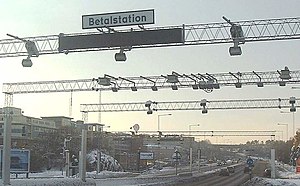Do Roads Pay for Themselves? Setting the Record Straight on Transportation Funding (45 page pdf, U.S. PIRG Education Fund, Jan. 2011)
Also discussed here: do roads pay for themselves? (Human Transit, Jan. 6, 2011)
Although the report reviewed today examines how roads are paid for in the USA (and how that is not just sales tax on gas), many of its conclusions apply elsewhere in these times of “shovel-ready” projects which often are aimed at road paving or building. Several recommendations concern road pricing and congestion charges as a more effective economic tool.
Key Quotes:
“Gasoline taxes aren’t “user fees:
- Fees” are not connected to “use”
- State gas taxes are often not entirely
- Federal gas taxes have typically not been devoted exclusively to highways
- Many states use gas tax revenue for a variety of purposes”
“most of the money that is spent on local roads and streets—which account for the majority of public road lane-miles and about 13 percent of vehicle travel—comes not from “user fees” but from other taxes, often local property taxes”
“Unlike gasoline taxes, tolls are true user fees—users pay them, non-users don’t, and users generally pay in proportion to the amount of the service they consume”
“How Best to Price Transportation:
*Economic principles suggest that in a competitive market, the price of a good or service will align with its “marginal cost”—that is the cost of producing one additional unit of the good or service. Transit service provides a good example..”
*prices should reflect the total costs imposed by additional users—including costs on the rest of society.. A weekday afternoon bus rider may impose little in the way of external costs, but a weekday afternoon driver will, in the form of air pollution, oil consumption, and a range of other impacts.
*In the case of automobile travel, an optimal pricing system might include congestion pricing, fees for emissions of greenhouse gases and other air pollutants, an end to free or subsidized parking, and the shifting of some costs (such as auto insurance) from lump-sum charges to charges that vary based on the number of miles driven
Related articles
- Actually, Highway Builders, Roads Don't Pay For Themselves (dc.streetsblog.org)
- Can a Distance Based Tax Replace the Gas Tax? (pollutionfree.wordpress.com)
- Congestion and Road Pricing in Canada (pollutionfree.wordpress.com)
- Report: Gas tax, car charges only cover half the cost of road maintenance (nj.com)
- What do Cars Cost Society? (pollutionfree.wordpress.com)
- Congestion Pricing: To Skip Traffic, Atlanta Says Pay Up (time.com)
- Belfer Center report calls for policymakers to begin taking steps to change policies for funding US transportation infrastructure (greencarcongress.com)


No comments:
Post a Comment